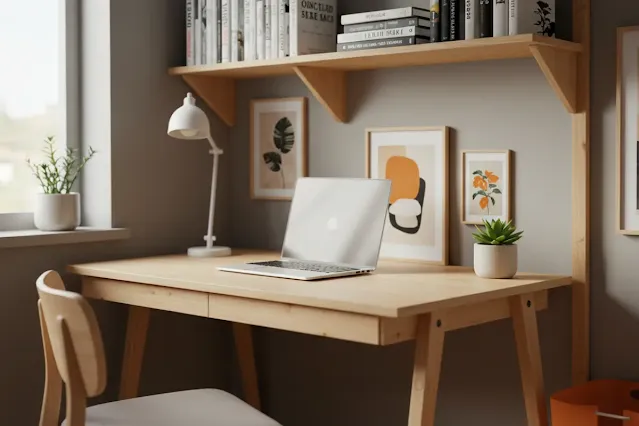10 Essential Tips for Designing a Wooden Desk That Works in Small Spaces
Designing a home workspace in a small area requires more than just scaling down furniture—it demands creativity, efficiency, and a clear understanding of how to make the most of what little room you have. A well-designed wooden desk can become the centerpiece of your productivity zone, offering both functionality and aesthetic warmth. But how do you get it right when square footage is limited?
Whether you're buying a compact desk or planning a DIY woodworking project, these 10 essential tips will help you create a space-saving wooden desk that’s both practical and beautiful.
Wooden Desk Design Tips for Small Spaces
- Measure Twice, Build (or Buy) Once: Before anything else, take accurate measurements of the space you have available.. Don’t just measure width—consider depth, height, door clearance, and walkways. In small rooms, even an extra inch or two can make the difference between a comfortable setup and a cramped corner. Sketch a quick floor plan or use an online room planner to visualize how your desk will fit.
- Prioritize Multi-Functional Design: In tight spaces, furniture should do more than one job. Look for wooden desks with built-in drawers, shelves, or vertical storage features. Better yet, consider a desk that can fold up, slide out, or transform into another piece of furniture, such as a cabinet or a dining table. Multipurpose designs make your space feel larger without sacrificing functionality.
- Use Vertical Space: When horizontal space is limited, think vertically. Wall-mounted wooden shelves, pegboards, or ladder-style desks allow you to store items above the work surface, keeping your desktop clean and clear. Natural wood tones add warmth to your walls while keeping everything within arm’s reach.
- Choose the Right Type of Wood: Wood choice affects not just the look, but also the weight and durability of your desk. Light-colored woods like pine, maple, and birch are great for brightening small rooms and tend to be more expensive.. Hardwoods like oak or walnut provide a premium finish but can be heavier and pricier. For DIY builds, plywood or reclaimed wood can be a smart, sustainable option.
- Keep the Design Minimal: The best desks for small spaces tend to follow minimalist design principles: clean lines, open legs, and few unnecessary details. Avoid ornate carvings, chunky hardware, or thick surfaces that make the desk appear bulky. A slim, streamlined design can make your workspace feel more open and breathable.
- Opt for Wall-Mounted or Floating Desks: Floating desks that mount directly to the wall are ideal for very small rooms or awkward layouts. They can be customized to fit any height, width, or finish, and they visually free up floor space. Some fold up when not in use, making them ideal for multipurpose rooms like bedrooms or kitchens.
- Don't Skip Ergonomics: Even in a small space, comfort matters. Make sure the height of your desk matches your chair and that you have enough room for your legs. A small but ergonomically correct desk setup is far better than a larger one that causes discomfort or strain.
- Hide Cables and Chargers: A clutter of cables is a visual distraction and can make a small office look cluttered. Build in grommets, cable trays, or wooden channels to manage wires neatly. Some desk designs include hidden compartments or rear access panels specifically for this purpose. Wireless accessories can also help reduce clutter.
- Personalize with Natural Finishes: One of the joys of using wood is how customizable it is. Choose a finish that complements your interior style—whether it’s natural, stained, painted, or distressed. Even a small desk can make a design statement when the wood grain is allowed to shine.
- Incorporate Lighting Thoughtfully: Good lighting is essential, especially in small areas where shadows can make a space feel even tighter. Install a small LED lamp on the desk or mount a work light on the wall above.Warm-toned lighting works beautifully with wood, enhancing its texture and color.
How to Add Style Without Losing Function
Creating a stylish yet functional small wooden desk is all about balance. In tight spaces, every design element must earn its place. Start by choosing clean, minimalist lines that visually open up the room. Opt for warm wood tones or subtle finishes like matte white or light oak that blend well with most decor styles. To add personality, incorporate tasteful accents—such as brass drawer pulls, leather cable holders, or a handmade wooden organizer—that don’t interfere with usability. Avoid heavy ornaments or bulky decor that may consume workspace. Instead, hang a small framed artwork above the desk, use a slim desk lamp with a stylish design, or place a small plant to bring life without clutter. With thoughtful choices, your desk can reflect your aesthetic while still supporting your productivity.
Conclusion
Small space doesn't necessarily mean small ambitions.. With thoughtful planning and smart wooden design, you can create a highly functional, inspiring workspace in even the tiniest room. Whether you prefer to build it yourself or find the perfect ready-made solution, these tips will help you design a desk that looks great, works well, and fits perfectly into your lifestyle.


